Naturalist’s Notebook: April 30, 2016 – May 06, 2016
Bright sunshine greeted the passengers of the Dolphin 8 on April 30. And it was under that bright sunshine that they were treated to views of 4 species of whales. The Atlantic White-sided dolphins seen by the morning’s passengers delighted them as they swam around the boat, allowing all aboard to get superb looks. If they weren’t enough, there was also the lunge-feeding Finback whale and the lunging Humpbacks.
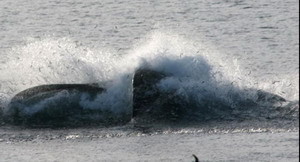
The highlight of the day, according to Nancy Scaglione-Peck, was the breaching Right whale calf. A breach, for any of you that are new to this, is when the whale throws part or all of its body above the surface of the water. It is thought to be a way they communicate, a way they groom themselves, and play behavior. Because of their shape, when a Right whale breaches, it causes a huge splash. It was likely that splash that lured the Dolphin 8 to just beyond Race Point. Alas, that is all the detail contained in the report and there are no pictures to go with it.
The Humpback whales seen on May 01 did nearly everything that Humpbacks are commonly known for. If you have been whalewatching and seen Humpbacks, you are probably aware that seeing them lunge-feed is a very exciting experience, especially when they are just lunging through the surface without blowing bubbles. You also would know that seeing one chin-breach, or lob-tail, or flipperslap is also an amazing adventure. You would also know how rare it is to witness any one of these behaviors on a whalewatch. But to see all of them, in addition to spinning head-breaching and tail-breaching, on just one trip is well beyond anything that any whalewatcher should ever expect. If you were one of the lucky few that braved the gray skies and the brief showers this day, you should consider yourself incredibly fortunate. IT ALMOST NEVER LOOKS LIKE THAT!!! And, if you were there and decide to come back again, forget what you saw before you leave the pier.
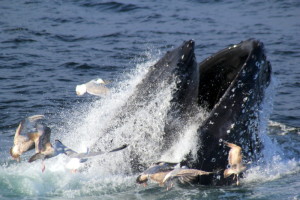
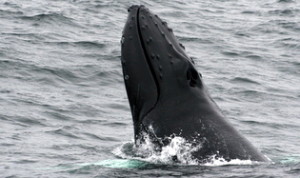
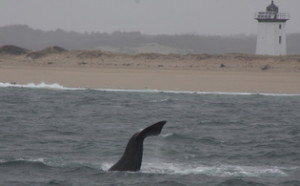
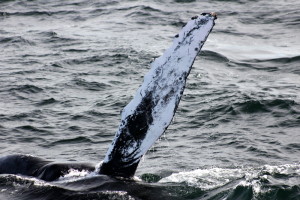
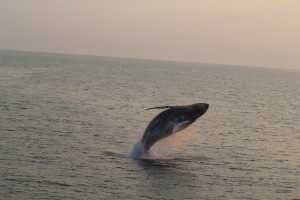
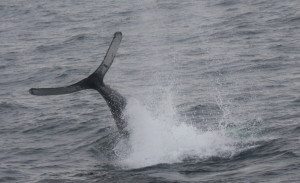
Because of the sea conditions on May 02, it was difficult to tell why the 2 Finback whales were behaving the way they were. They might have just been foraging or they might have found a large school of fish beneath the surface that they were feeding on. Finback whales very rarely raise their flukes above the surface of the water when they are diving, meaning that the underside of their tails (though a bit generic) are seldom seen from a boat. What we saw at the surface was a number of sharp turns that had the whales roll enough on their sides to expose the undersides of one of their flukes. This occured several times while the passengers of the Dolphin 8 watched. A third Finback whale, named Braid, was seen separately and in the waters of Cape Cod Bay. This Finner chose the moment when the boat was closest to it to defecate. As the naturalist on this trip, I was very fortunate to find several passengers aboard that were as excited about this as I was.
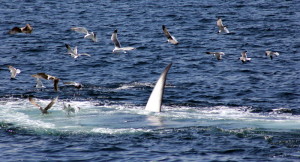 Note: This photo is of a feeding finback whale from May of 2012.
Note: This photo is of a feeding finback whale from May of 2012.
Many years ago, when I was first beginning my career as a naturalist, I went to visit my sister and her family in Pennsylvania. My oldest nephew, 4 or 5 at the time, took me for a tour around their yard. During this tour, he pointed out the swing set and showed me the shed where the tools were kept. He showed me where the rabbit hole was, and the bird’s nest. And he pointed out every little pile of dog dirt. And I was honestly amazed at just how fascinated he was by poop. I was amazed until the first youngster on the boat asked me, “What is whale poop like?” What ended my amazement was not that a young person asked about whale poop, but the number of adults within earshot that all of a sudden quieted down to hear my answer. And for over a decade, that seems to be the way of it. Adults seem to want to hear the answer, but rarely are willing to ask the question. Thank God for kids!
Adults, don’t feel the need to by shy about asking. When Dr. Roman spoke to a hundred plus naturalists and docents this spring and told them he intended to talk about whale poop, there were suddenly a hundred plus 5 year olds in his audience. Remember that it is good to be curious and that whale poop is very important in the marine ecosystem as a way to recover the nitrogen that would be lost to the depths of the sea without it.
The drizzle continued on and off for most of the day on May 02. As we were nearing Race Point, on the way back to Provincetown, going through waters that we had been through just a half hour or so before, we spotted several spouts. At one point, an area of the sea surface about the size of a compact car, seemed suddenly to be getting more rain than the surface around it. Through that boiling point of the sea a large, dark body lunged with its mouth open. In the end, the humpback whale rose head first to about a third of its length above the water before closing its mouth and dropping back into the sea. As exciting as the repeated lunge-feeding of this humpback whale was, it was also interesting that when we had passed through there just a half hour before, it did not appear to be there. The environment we whalewatch in is very wild and very dynamic. Something that should always be kept in mind by anyone operating a vessel.
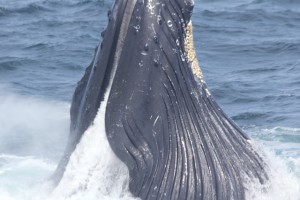
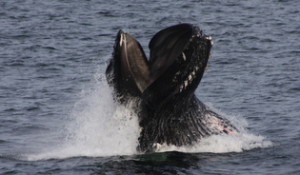
Good looks at Humpback whales, Finback whales, and Minke whales were enjoyed by the passengers for the rest of the week.





